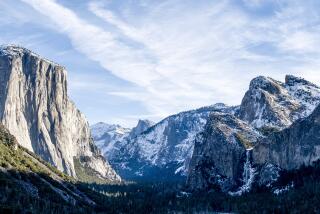Yellowstone Lives On
- Share via
Western senators and congressmen still are beating the bushes for scapegoats in the aftermath of last summer’s fires in and around Yellowstone National Park. As the new session of Congress was getting under way, Sen. Alan K. Simpson (R-Wyo.) told a Wyoming newspaper that congressional hearings would have two major goals: “to avoid this kind of thing in the future and to pin blame for what happened in the past.” There would be a new cast of characters in the National Park Service under the Bush Administration, he said, and they would be selected to some degree on the basis of fire-fighting policy.
Such retribution is senseless. A careful analysis of what really happened in Yellowstone last summer demonstrates that very little could have been done to affect the scope of the fires or the extent of destruction. The chairman of a federal fire-management review team said that “there never was a way to preclude what happened in Yellowstone this year.”
The review team, while not passing judgment on the Yellowstone decisions, defended the National Park Service’s policy of permitting certain naturally caused fires to burn themselves out in pursuit of acceptable ecological goals. But the officials added that fire-fighting efforts might have to be undertaken in some instances because of social and economic consequences. The Yellowstone fires were fought with considerable success in preventing economic loss, specifically in the saving of man-made structures like Old Faithful Inn and related buildings. But the major damage may have been political, as officials like Simpson and Sen. Malcolm Wallop (R-Wyo.) joined the panicky attacks on Park Service and Interior Department officials for not doing more to stop the fires.
In fact, the fires burned far less acreage than was being reported last August and September. The biggest fires were fought from the beginning because they had been man-caused. The majority of the large fires did not even begin within Yellowstone, but in lands outside the park under the jurisdiction of the U.S. Forest Service, which has a more vigorous fire-suppression policy.
One of the best retrospectives of the park fires, written by nature writer Ted Williams, appeared in the January issue of Audubon magazine. Williams was vacationing in Yellowstone during the peak of the long fire season. From his own observations, and from follow-up research, Williams found that while the fire perimeter encircled 1.4 million acres, the vegetation in 30% to 70% of that area was untouched. “I’d seen and guessed that there was 10% black,” Williams wrote, but the Park Service estimated 20%.
Some plant life remained in all but one-tenth of 1% of the 1.4 million acres. While the politicians had complained about the sterilization of the soil in vast stretches of the fire area, implying that nothing would grow there again, soil scientists and wildlife biologists said that there was no soil sterilization, even in the most intensely burned regions.
Critics also complained that the Park Service was reluctant to use bulldozers to cut fire lines. The lines that were actually plowed with the machines proved ineffective. Foot crews armed with axes worked best. Much of the damage that the Park Service must contend with was caused by bulldozers where they were allowed to tear up meadows.
The fires were part of a natural process that probably would have, and should have, occurred decades ago but for past policy of putting out every fire as soon as possible. This permitted dry fuel to build up on the forest floor. Turned to tinder by drought conditions, all it needed was one spark.
As Williams left Yellowstone last fall, he said that he reflected on all the changes that Yellowstone had undergone since the last Ice Age. Except for the wolves hunted to extinction in the area, all of Yellowstone was still there. “Nothing basic had changed,” he said. “The park had survived all those millennia with scarcely any human help.” And, presumably, Yellowstone will survive even the angry politicians still seeking scapegoats.
More to Read
Sign up for Essential California
The most important California stories and recommendations in your inbox every morning.
You may occasionally receive promotional content from the Los Angeles Times.













